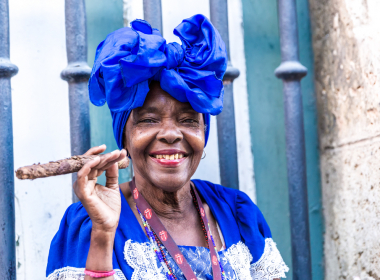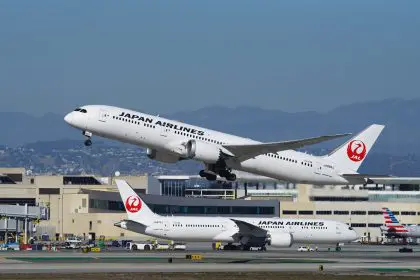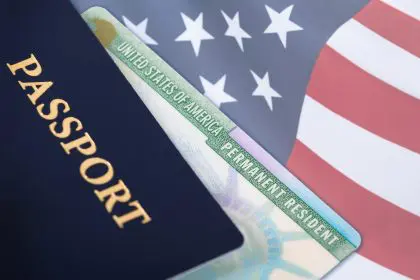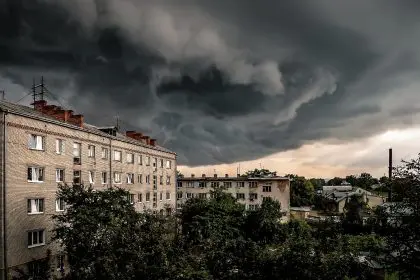The Soviet Union was commonly called the “Iron Curtain” back during the height of the Cold War, so certainly Cuba can be thusly called the “Palm Curtain” due to its forbidden fruit image, tropical allure and Communist perspective on this island of 11 million people. The capital of Cuba is Havana and the second largest city is Santiago de Cuba in this country struggling for redevelopment after America’s infamous embargo and the fall of the Soviet Union, yet it has both a high life expectancy and literacy rate even as it is considered a developing country. As I arrived at Jose Marti International Airport in Havana Cuba, thoughts of how this Island was such a pivotal place in world history, one feels as though they have stepped back in time as I ride toward my hotel in one of these classic cars as my skillful driver maneuvers this drop top 57 Chevy in a parade of other classic cars navigating congested Havana. Cuba’s diversity is reflected in the faces of those as I pass the iconic Revolutionary Square, where the Jose’ Marti’ Monument resides and the place where Fidel and Raul Castro would speak for hours to millions facing another iconic image reflected by the face of Argentinian Ernesto Che’ Guevara on a building nearby, who remains a lasting hero of the Cuban Revolution.
In 1959, Castro and his band of revolutionaries inspired by their July 26 Movement that marked the first attempt by Castro to overthrow the government of Fulgencio Batista, he would meet Che’ and others exiled in Mexico to depart there for a journey that would change the course of world history with the Cuban Missile Crisis in October 1962, that literally brought the world to the edge of a nuclear war. Historically, Cuba under Castro was a major contributor to anti-imperialist wars in Africa, Central America and Asia. Castro sent tens of thousands of troops to Angola when Apartied South Africa was invading Angola. Historically, Cuba is the only minor developing country to have projected influence on the world stage that has a characteristic of a major global power. Present Cuba is contrast with some revamped hotels and classic cars that remain relics of days of old and the current infrastructure has very little importation of new products. The population of Cuba has very complex origins and intermarriage between diverse groups is general. The Institute for Cuban and Cuban-American Studies at the University of Miami say that 62% is Black which is interesting. The Cuban people are known to be friendly and courteous but one is taken by surprise to learn the most popular foreigner that Cubans take great interest in is Americans. Around Havana, one notices many monuments to The Revolution in 1959 but very little images of Fidel and Raul Castro only Che Guevara and Camilo Cienfuegos who remain martyrs with Che being assassinated October 9, 1967 in Bolivia and Camilo dying in a plane crash October 28, 1959 shortly after the Revolution. There is a monument to Afro Cuban hero Antonio Maceo, who was a key figure in the war of independence against Spain and was commonly called, “The Bronze Titan” as an almost a mythical icon on the level of Jose’ Marti’, the central person in opposition to Spain’s colonization of the island and iconic hero of Fidel Castro.
Between me getting rest at Hotel National, where Nat King Cole, Frank Sinatra, Ava Gardner and many others graced its hallways, I loved seeing Old Havana which has a historic colonial splendor about it with the old buildings, plaza, cobblestone walkways and those wonderful Afro Cuban sisters wearing colorful decorative dresses, smoking those Cuban cigars, certainly I helped myself to a few during my visit. In Cuba, along with other parts of the Caribbean and South America, the Santeria Religion is very popular. This religion is considered a syncretic Yoruba based religion of West Africa with elements of voodoo, Roman Catholicism and Christian nomenclature. Cuba is official a secular state and religious freedoms increased during the 1980s. Cuban culture is influenced by its melting pot of cultures, primarily those of Africa and Spain. Cuban music is very rich and is the most commonly known expression of culture. The cuisine of Cuba is a fusion of Spanish, African and Caribbean influences. Though the US embargo has affected all Cubans, the free health care, education and overall literacy programs instituted by the Castro government seemingly has made Cuba a highly literate, healthy society. Despite tremendous economic hardships, Cuba does seem to be making a great effort to equalize opportunity for all which has been the lasting testament to the Revolution- behind the Palm Curtain.
Malik Ismail is an international traveler and activist. He’s explored many cultures in Africa including Ghana, South Africa and Egypt. He’s traveled to Cuba and South America. This year he visited Rio de Janeiro and Salvador Bahia, Brazil including the favelas of Rocinha and Cidade de Deus (City of God) in Rio. His writings have been featured in the L.A. Watt’s Times, It’s About Time Newsletter, Rolling Out Magazine and The Black Panther Intercommunal News Service.
















